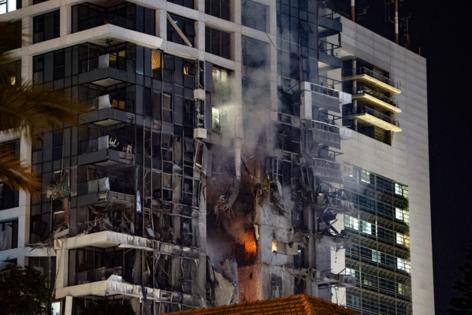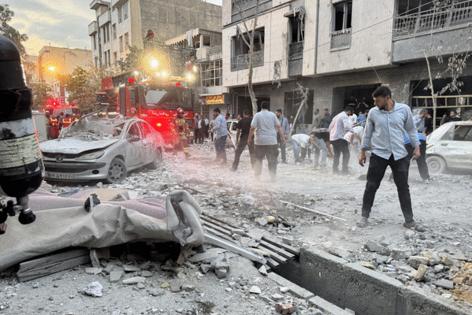Israel launches withering attack on Iran, spurring retaliation and fears of all-out war
Published in News & Features
AMMAN, Jordan — Iran launched successive missile barrages on Israel late Friday, a retaliation for a punishing Israeli campaign the same day that wiped out the upper echelons of Iran’s military leadership along with important parts of its nuclear and military infrastructure.
The exchanges constituted the most significant escalation between the longtime adversaries — raising the possibility of a protracted conflict and fears the U.S. would become embroiled in another war in the Middle East.
Sirens echoed in Jerusalem and Tel Aviv, with the nighttime skies over the latter lighted with bursts of yellow as missiles from Israel’s Arrow defense system lanced up to intercept Iranian ballistic missiles. The bass-drum beat of multiple explosions could be heard as far away as neighboring Jordan.
Broadcasts from Tel Aviv showed a residential tower with fire raging inside a number of apartments, while other video showed smoke wreathing several buildings in central parts of the city and missiles falling on empty intersections.
Videos from Iran and published on social media depicted fire and visible damage to several residential buildings in Tehran. Others showed entire buildings having collapsed, with rubble carpeting the street. One image — the Los Angeles Times could not verify its authenticity — showed a bloodied child lying on a debris-covered floor.
Israeli officials said more than 40 people were wounded and that rescue crews were examining nine reported impact sites in central Israel. In Iran, news outlets reported 78 dead and more than 320 wounded in Israel’s attacks, which also struck residential areas.
At least five people, including three children, were injured by shrapnel from a missile that fell near the West Bank city of Hebron on Friday evening, according to WAFA, the official Palestinian Authority news service. The Israeli military, which said the missile that fell in the area came from Yemen, said “no interceptors were launched.”
Iran’s Islamic Revolutionary Guard Corps said in a statement that Iranian forces conducted a “crushing and precise response against dozens of targets, military centers and airbases” in Israel.
“They started this and now they’ve launched a war,” said Iran’s Supreme Leader Ayatollah Ali Khamenei in a statement, adding that Israel would not be allowed to conduct what he called “hit-and-run” attacks without grave consequences.
“The Iranian nation must be sure that our response will not be half-measured.”
Israeli Defense Minister Israel Katz said Iran “crossed red lines after it dared to fire missiles at civilian population concentrations in Israel.”
The Israeli prime minister, Benjamin Netanyahu, said Israel acted “to thwart the Islamic regime’s nuclear and ballistic missile threat to us,” adding, “more is on the way. The regime does not know what hit them, or what will hit them.”
Israel launched a compound operation involving 200 warplanes and drones hitting more than 100 nuclear sites, ballistic missile factories and other military areas across the country, including in Natanz — home to Iran’s main nuclear enrichment facility — along with Kermanshah, Tabriz and Isfahan.
President Donald Trump lauded Israel’s operation, describing it in an interview with ABC News as “excellent” and warning more attacks would be forthcoming if Iran’s leadership did not negotiate a new nuclear deal.
“I think it’s been excellent,” Trump said. “We gave them a chance and they didn’t take it. They got hit hard, very hard. They got hit about as hard as you’re going to get hit. And there’s more to come. A lot more.”
Explosions began to rock Tehran shortly after 3 a.m., with blasts reported in the Iranian capital’s central, northeastern and northwestern neighborhoods.
Iran’s Foreign Minister Abbas Araghchi said Israel’s campaign was a “declaration of war,” adding in a letter to the United Nations — and later published on his Telegram channel — that the U.N. Security Council should “immediately address this issue.”
The strikes proved to be a devastating blow to Iran’s top military leadership and a demonstration of Israel’s intelligence infiltration, hitting senior members of Iran’s chain of command in their homes.
Iranian state and local media confirmed the death of Maj. Gen. Mohammad Bagheri, the Iranian armed forces’ chief of staff; Maj. Gen. Hossein Salami, commander of the Islamic Revolutionary Guard Corps; Maj. Gen. Gholam Ali Rashid, an IRGC commander who heads the army’s central headquarters; and Amir Ali Hajizadeh, the head of the Islamic Revolutionary Guard Corps’ Aerospace Forces. Also killed were veteran nuclear scientists Fereydoon Abbasi, Abdolhamid Minoucher and Mohammad-Mehdi Tehranchi, according to the semiofficial Iranian outlet Press TV.
Ali, a resident living a few blocks away from one of the targeted sites who gave only his first name to avoid harassment, was praying when he heard huge explosions around him.
“The floor started shaking, so I stopped praying and ran outside,” he said. He went down the street and found smoke coming out of the second floor of a six-story building, with people shouting on the street.
Later, an official with Israel’s Mossad said in an interview with Israeli daily newspaper Times of Israel that the spy agency smuggled vehicles carrying weapons systems and constructed a secret explosive drone base in Iran ahead of the operation. The official added that the swarm of explosive drones was used to destroy ballistic missile launchers to cripple Iran’s ability to thwart the strikes.
Behrouz Kamalvandi, the spokesman for the Iranian Atomic Energy Organization, said in an interview on state TV that there were no casualties and that initial assessments showed that damage to Natanz was “superficial.” He added that there was no external contamination.
Iran’s leadership said Friday’s attacks were only the start of their retaliation.
Yet it remains unclear how Tehran can make good on that threat. In the past, it could rely on a network of militias and sympathetic governments in Lebanon, Yemen, Syria, Iraq and Gaza that were collectively known as the “Axis of Resistance.”
But the last 20 months have seen Israel systematically cripple the Lebanese militant group Hezbollah, while the fall of Iranian ally Syrian President Bashar Assad has denied Tehran a passageway to Israel’s borders; its Iraqi militia allies have kept a low profile in recent months and Hamas and Palestinian Islamic Jihad are facing their own wide-ranging offensives in Gaza. And previous ballistic missile and drone barrages by Iran and Yemen’s Houthis have had little effect on Israel’s defenses.
Hours after the initial Israeli strikes, crowds streamed into Tehran’s streets, calling for revenge and chanting “Death to Israel. Death to America.” Others queued before gas stations and supermarkets, preparing for what they thought would be a long war.
As the Iranian drones winged their way to Israel, Jordan warned citizens to keep indoors and avoid open areas. Later, sirens sounded in Amman, even as the missiles and the interceptors rising to meet them could be seen in the skies over the Jordanian capital. Jordanian jets scrambled to shoot down some of the projectiles flying through the country’s airspace, after assessments said the missiles were likely to fall on Jordanian territory, the Jordanian military said.
In the initial hours after the strike, U.S. Secretary of State Marco Rubio sought to distance the U.S. from Israel’s attacks, describing them as a “unilateral action” that Israel believed “was necessary for its self-defense.”
But that messaging was likely undercut by Trump’s statements putting pressure on Iran’s leadership to continue negotiating.
“I gave Iran chance after chance to make a deal. I told them, in the strongest of words, to ‘just do it,’ but no matter how hard they tried, no matter how close they got, they just couldn’t get it done... They are all DEAD now, and it will only get worse!” Trump wrote in a Truth Social post. He added that, “Iran must make a deal, before there is nothing left.”
A U.S. official, speaking on condition of anonymity to speak candidly, told The Times that the Iranians had reached out to Trump administration officials after the Israeli strike — a sign, to them, of the success of the Israeli operation and of desperation in Tehran. But it is unclear what will be left to discuss regarding Iran’s nuclear program, the official added.
“It’ll be hard to break out,” the official said, referring to the sprint from fissile material to warheads, “if you have no nuclear infrastructure left.”
Netanyahu, in a televised address, appealed to the Iranian people, saying now was the time for them to rise up against repressive leaders. “This is your opportunity to stand up and let your voices be heard. Woman, Life, Freedom — Zan, Zendegi, Azadi,” Netanyahu said, employing the slogan of anti-government protests in Iran.
The U.S. Navy repositioned some of its forces in anticipation of Iran’s retaliatory attacks. The USS Thomas Hudner, a guided missile destroyer, was dispatched to the eastern Mediterranean while another destroyer was made available if requested by the White House, according to two U.S. officials speaking to the Associated Press.
Israel’s operation spurred a raft of condemnations from regional countries. Saudi Arabia’s foreign ministry denounced the “heinous Israeli attacks against the brotherly Islamic Republic of Iran.”
Oman, the main mediator between the U.S. and Iran in recent months, said the attacks were “unacceptable and ongoing aggressive behaviour that undermines the foundations of stability in the region.”
In a statement, U.N. Secretary-General Antonio Guterres called for “maximum restraint” to avoid “descent into deeper conflict.”
Trump insisted that there was still a chance for diplomacy.
“Two months ago I gave Iran a 60-day ultimatum to ‘make a deal.’ They should have done it! Today is day 61,” he wrote in a post on Truth Social.
“I told them what to do, but they just couldn’t get there. Now they have, perhaps, a second chance!”
(Staff writer Michael Wilner contributed to this report from Washington.)
©2025 Los Angeles Times. Visit at latimes.com. Distributed by Tribune Content Agency, LLC.










Comments